What is Nigeria’s location and importance?
Nigeria is located in West Africa, sharing a border with Benin, Niger, Chad and Cameroon. To the south, it borders the Gulf of Guinea, part of the Atlantic Ocean. Nigeria has a range of natural environments, from semi-deserts in the north to tropical rainforest in the south.
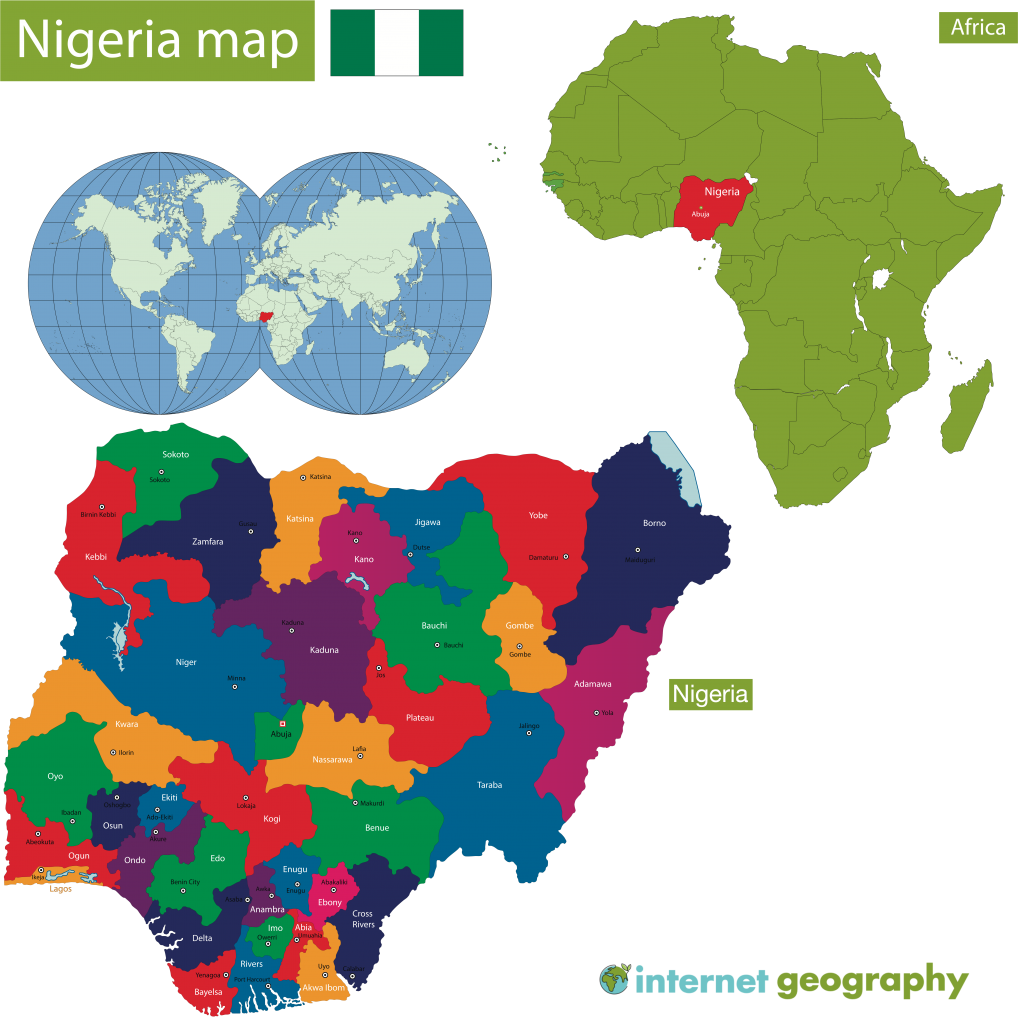
A map to show the location of Nigeria
Nigeria is almost 4 times the physical size of the UK. Its population, at just over 200,000,000, is three times the size of the UK.
Nigeria is the most populous and economically developed country in Africa. Its recent growth, based on the sale of oil, has led to the country’s transformation from a LIC to a NEE.
What is the global importance of Nigeria?
According to the World Bank Nigeria had the 31st largest GDP in 2018. It is the world’s 21st largest economy and has experienced recent rapid growth. According to the United Nations, it has the 7th largest population in the world. Nigeria is the 13th largest producer of oil according to the US Energy Information Administration.
Lagos, Nigeria’s largest city, is a thriving ‘world city’, with a strong financial and economic base.
Nigeria has the second-largest film industry in the world, ahead of the United States and behind India. Nigerian cinema is known as “Nollywood”.
Nigeria plays an important role in United Nations peacekeeping. According to the United Nations “Since the 1960s, Nigeria has been a major contributor of troops and police to United Nations peace operations, having served in dozens of missions. Most recently, Nigerian troops were the military backbone of the UN Mission in Liberia (UNMIL).
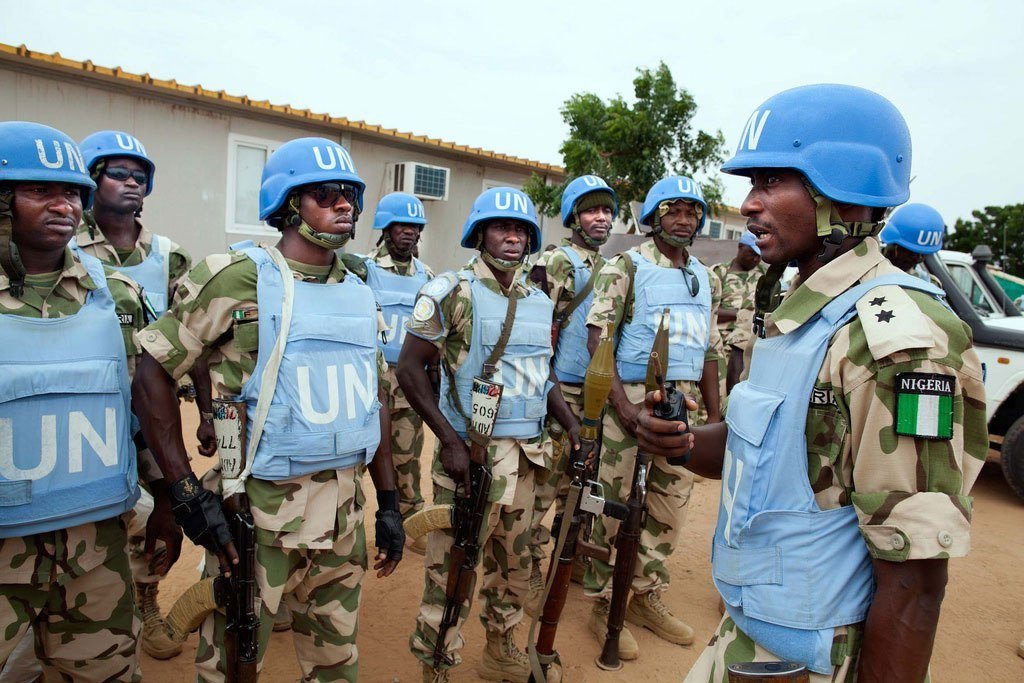
Nigerian UN peacekeepers
What is the regional importance of Nigeria?
Nigeria has the fastest growing economy in Africa and the highest GNP on the continent. Nigeria has the largest population on the continent and the third-largest manufacturing sector. The country also has the largest agricultural output and the highest number of cattle.
Nigeria has a rich culture. Nigerian music is enjoyed throughout Africa. It is also a hub for literature boasting a range of popular writers. One of the main founders of the Organisation of African Unity (now the African Union or AU) was the president of Nigeria in 1963.
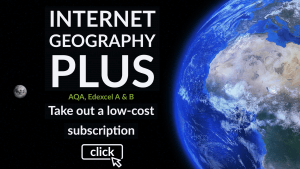
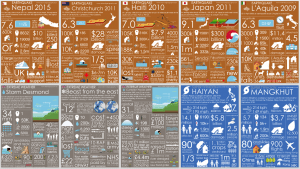
Premium Resources
Please Support Internet Geography
If you’ve found the resources on this page useful please consider making a secure donation via PayPal to support the development of the site. The site is self-funded and your support is really appreciated.
Nigeria

In ancient and pre-colonial times, the area of present-day Nigeria was occupied by a great diversity of ethnic groups with different languages and traditions. These included Islamic empires in northern Nigeria and smaller organized political groupings in southern Nigeria. British influence and control over what would become Nigeria and Africa’s most populous country grew through the 19th century. In 1914, the British amalgamated their separately administered northern and southern territories into modern-day Nigeria. A series of constitutions after World War II granted Nigeria greater autonomy. After independence in 1960, politics were marked by coups and mostly military rule, until the death of a military head of state in 1998 allowed for a political transition. In 1999, a new constitution was adopted and a peaceful transition to civilian government was completed. The government continues to face the daunting task of institutionalizing democracy and reforming a petroleum-based economy, whose revenues have been squandered through decades of corruption and mismanagement. In addition, Nigeria continues to experience longstanding ethnic and religious tensions. Although both the 2003 and 2007 presidential elections were marred by significant irregularities and violence, Nigeria is currently experiencing its longest period of civilian rule since independence. The general elections of 2007 marked the first civilian-to-civilian transfer of power in the country’s history. National and state elections in 2011 and 2015 were generally regarded as credible. The 2015 election was also heralded for the fact that the then-umbrella opposition party, the All Progressives Congress, defeated the long-ruling People’s Democratic Party that had governed since 1999, and assumed the presidency, marking the first peaceful transfer of power from one party to another. Presidential and legislative elections were held in early 2019 and deemed broadly free and fair despite voting irregularities, intimidation, and violence.
Visit the Definitions and Notes page to view a description of each topic.
Geography
Location
Western Africa, bordering the Gulf of Guinea, between Benin and Cameroon
Geographic coordinates
Map references
total: 923,768 sq km
land: 910,768 sq km
water: 13,000 sq km
Area – comparative
about six times the size of Georgia; slightly more than twice the size of California

Land boundaries
total: 4,477 km
border countries (4): Benin 809 km; Cameroon 1,975 km; Chad 85 km; Niger 1,608 km
Coastline
Maritime claims
territorial sea: 12 nm
exclusive economic zone: 200 nm
continental shelf: 200-m depth or to the depth of exploitation
Climate
varies; equatorial in south, tropical in center, arid in north
Terrain
southern lowlands merge into central hills and plateaus; mountains in southeast, plains in north
Elevation
highest point: Chappal Waddi 2,419 m
lowest point: Atlantic Ocean 0 m
mean elevation: 380 m
Natural resources
natural gas, petroleum, tin, iron ore, coal, limestone, niobium, lead, zinc, arable land
Land use
agricultural land: 78% (2018 est.)
arable land: 37.3% (2018 est.)
permanent crops: 7.4% (2018 est.)
permanent pasture: 33.3% (2018 est.)
forest: 9.5% (2018 est.)
other: 12.5% (2018 est.)
Irrigated land
2,930 sq km (2012)
Major lakes (area sq km)
fresh water lake(s): Lake Chad (endorheic lake shared with Niger, Chad, and Cameroon) – 10,360-25,900 sq km
note – area varies by season and year to year
Major rivers (by length in km)
Niger river mouth (shared with Guinea [s], Mali, Benin, and Niger) – 4,200 km
note – [s] after country name indicates river source; [m] after country name indicates river mouth
Major watersheds (area sq km)
Atlantic Ocean drainage: Niger (2,261,741 sq km)
Internal (endorheic basin) drainage: Lake Chad (2,497,738 sq km)
Major aquifers
Lake Chad Basin, Lullemeden-Irhazer Aquifer System
Population distribution
largest population of any African nation; significant population clusters are scattered throughout the country, with the highest density areas being in the south and southwest as shown in this population distribution map
Natural hazards
periodic droughts; flooding
Geography – note
the Niger River enters the country in the northwest and flows southward through tropical rain forests and swamps to its delta in the Gulf of Guinea
People and Society
Population
225,082,083 (2022 est.)
note: estimates for this country explicitly taken into account the impact of the HIV/AIDS epidemic
Nationality
noun: Nigerian(s)
adjective: Nigerian
Ethnic groups
Hausa 30%, Yoruba 15.5%, Igbo (Ibo) 15.2%, Fulani 6%, Tiv 2.4%, Kanuri/Beriberi 2.4%, Ibibio 1.8%, Ijaw/Izon 1.8%, other 24.9% (2018 est.)
note: Nigeria, Africa’s most populous country, is composed of more than 250 ethnic groups
Languages
English (official), Hausa, Yoruba, Igbo (Ibo), Fulani, over 500 additional indigenous languages
Religions
Muslim 53.5%, Roman Catholic 10.6%, other Christian 35.3%, other .6% (2018 est.)
Demographic profile
Nigeria’s population is projected to grow from more than 186 million people in 2016 to 392 million in 2050, becoming the world’s fourth most populous country. Nigeria’s sustained high population growth rate will continue for the foreseeable future because of population momentum and its high birth rate. Abuja has not successfully implemented family planning programs to reduce and space births because of a lack of political will, government financing, and the availability and affordability of services and products, as well as a cultural preference for large families. Increased educational attainment, especially among women, and improvements in health care are needed to encourage and to better enable parents to opt for smaller families.
Nigeria needs to harness the potential of its burgeoning youth population in order to boost economic development, reduce widespread poverty, and channel large numbers of unemployed youth into productive activities and away from ongoing religious and ethnic violence. While most movement of Nigerians is internal, significant emigration regionally and to the West provides an outlet for Nigerians looking for economic opportunities, seeking asylum, and increasingly pursuing higher education. Immigration largely of West Africans continues to be insufficient to offset emigration and the loss of highly skilled workers. Nigeria also is a major source, transit, and destination country for forced labor and sex trafficking.
Age structure
0-14 years: 41.7% (male 45,571,738/female 43,674,769)
15-24 years: 20.27% (male 22,022,660/female 21,358,753)
25-54 years: 30.6% (male 32,808,913/female 32,686,474)
55-64 years: 4.13% (male 4,327,847/female 4,514,264)
65 years and over: 3.3% (male 3,329,083/female 3,733,801) (2020 est.)

Dependency ratios
total dependency ratio: 86
youth dependency ratio: 80.9
elderly dependency ratio: 5.1
potential support ratio: 19.6 (2020 est.)
Median age
total: 18.6 years
male: 18.4 years
female: 18.9 years (2020 est.)
Population growth rate
Birth rate
34.19 births/1,000 population (2022 est.)
Death rate
8.7 deaths/1,000 population (2022 est.)
Net migration rate
-0.21 migrant(s)/1,000 population (2022 est.)
Population distribution
largest population of any African nation; significant population clusters are scattered throughout the country, with the highest density areas being in the south and southwest as shown in this population distribution map
Urbanization
urban population: 53.5% of total population (2022)
rate of urbanization: 3.92% annual rate of change (2020-25 est.)
Major urban areas – population
15.388 million Lagos, 4.219 million Kano, 3.756 million Ibadan, 3.652 million ABUJA (capital), 3.325 million Port Harcourt, 1.841 million Benin City (2022)
Sex ratio
at birth: 1.06 male(s)/female
0-14 years: 1.04 male(s)/female
15-24 years: 1.03 male(s)/female
25-54 years: 1 male(s)/female
55-64 years: 0.96 male(s)/female
65 years and over: 0.77 male(s)/female
total population: 1.02 male(s)/female (2022 est.)
Mother’s mean age at first birth
20.4 years (2018 est.)
note: data represents median age at first birth among women 25-49
Maternal mortality ratio
917 deaths/100,000 live births (2017 est.)
Infant mortality rate
total: 56.68 deaths/1,000 live births
male: 62.03 deaths/1,000 live births
female: 51.01 deaths/1,000 live births (2022 est.)
Life expectancy at birth
total population: 61.33 years
male: 59.51 years
female: 63.27 years (2022 est.)
Total fertility rate
4.62 children born/woman (2022 est.)
Contraceptive prevalence rate
Drinking water source
improved: urban: 95.3% of population
rural: 68.8% of population
total: 82.6% of population
unimproved: urban: 4.7% of population
rural: 31.2% of population
total: 17.4% of population (2020 est.)
Current health expenditure
Physicians density
0.38 physicians/1,000 population (2018)
Sanitation facility access
improved: urban: 81.6% of population
rural: 41.4% of population
total: 62.3% of population
unimproved: urban: 18.4% of population
rural: 58.6% of population
total: 37.7% of population (2020 est.)
HIV/AIDS – adult prevalence rate
HIV/AIDS – people living with HIV/AIDS
1.7 million (2020 est.)
HIV/AIDS – deaths
Major infectious diseases
degree of risk: very high (2020)
food or waterborne diseases: bacterial and protozoal diarrhea, hepatitis A and E, and typhoid fever
vectorborne diseases: malaria, dengue fever, and yellow fever
water contact diseases: leptospirosis and schistosomiasis
animal contact diseases: rabies
respiratory diseases: meningococcal meningitis
aerosolized dust or soil contact diseases: Lassa fever
note 1: on 4 May 2022, the Centers for Disease Control and Prevention issued a Travel Health Notice for a Yellow Fever outbreak in Nigeria; a large, ongoing outbreak of yellow fever in Nigeria began in September 2017; the outbreak is now spread throughout the country with the Nigerian Ministry of Health reporting cases of the disease in multiple states (Bauchi, Benue, Delta, Ebonyi, and Enugu); the CDC recommends travelers going to Nigeria should receive vaccination against yellow fever at least 10 days before travel and should take steps to prevent mosquito bites while there; those never vaccinated against yellow fever should avoid travel to Nigeria during the outbreak
note 2: widespread ongoing transmission of a respiratory illness caused by the novel coronavirus (COVID-19) is occurring throughout Nigeria; as of 18 August 2022, Nigeria has reported a total of 262,664 cases of COVID-19 or 127.42 cumulative cases of COVID-19 per 100,000 population with a total of 3,147 cumulative deaths or a rate of 1.52 cumulative death per 100,000 population
note 3: on 21 March 2022, the US Centers for Disease Control and Prevention (CDC) issued a Travel Alert for polio in Africa; Nigeria is currently considered a high risk to travelers for circulating vaccine-derived polioviruses (cVDPV); vaccine-derived poliovirus (VDPV) is a strain of the weakened poliovirus that was initially included in oral polio vaccine (OPV) and that has changed over time and behaves more like the wild or naturally occurring virus; this means it can be spread more easily to people who are unvaccinated against polio and who come in contact with the stool or respiratory secretions, such as from a sneeze, of an “infected” person who received oral polio vaccine; the CDC recommends that before any international travel, anyone unvaccinated, incompletely vaccinated, or with an unknown polio vaccination status should complete the routine polio vaccine series; before travel to any high-risk destination, the CDC recommends that adults who previously completed the full, routine polio vaccine series receive a single, lifetime booster dose of polio vaccine
Obesity – adult prevalence rate
Alcohol consumption per capita
total: 4.49 liters of pure alcohol (2019 est.)
beer: 0.73 liters of pure alcohol (2019 est.)
wine: 0.09 liters of pure alcohol (2019 est.)
spirits: 0.4 liters of pure alcohol (2019 est.)
other alcohols: 3.27 liters of pure alcohol (2019 est.)
Tobacco use
total: 3.7% (2020 est.)
male: 6.9% (2020 est.)
female: 0.5% (2020 est.)
Children under the age of 5 years underweight
Child marriage
women married by age 15: 15.7%
women married by age 18: 43.4%
men married by age 18: 3.2% (2018 est.)
Education expenditures
Literacy
definition: age 15 and over can read and write
total population: 62%
male: 71.3%
female: 52.7% (2018)
School life expectancy (primary to tertiary education)
total: 9 years
male: 9 years
female: 8 years (2011)
Unemployment, youth ages 15-24
total: 18.3%
male: 18.4% NA
female: 18.2% (2019 est.) NA
Environment
Environment – current issues
serious overpopulation and rapid urbanization have led to numerous environmental problems; urban air and water pollution; rapid deforestation; soil degradation; loss of arable land; oil pollution – water, air, and soil have suffered serious damage from oil spills
Environment – international agreements
party to: Biodiversity, Climate Change, Climate Change-Kyoto Protocol, Climate Change-Paris Agreement, Comprehensive Nuclear Test Ban, Desertification, Endangered Species, Hazardous Wastes, Law of the Sea, Marine Dumping-London Convention, Marine Dumping-London Protocol, Marine Life Conservation, Nuclear Test Ban, Ozone Layer Protection, Ship Pollution, Wetlands
signed, but not ratified: Tropical Timber 2006
Air pollutants
particulate matter emissions: 48.73 micrograms per cubic meter (2016 est.)
carbon dioxide emissions: 120.37 megatons (2016 est.)
methane emissions: 143.99 megatons (2020 est.)
Climate
varies; equatorial in south, tropical in center, arid in north
Land use
agricultural land: 78% (2018 est.)
arable land: 37.3% (2018 est.)
permanent crops: 7.4% (2018 est.)
permanent pasture: 33.3% (2018 est.)
forest: 9.5% (2018 est.)
other: 12.5% (2018 est.)
Urbanization
urban population: 53.5% of total population (2022)
rate of urbanization: 3.92% annual rate of change (2020-25 est.)
Revenue from forest resources
forest revenues: 1.02% of GDP (2018 est.)
Revenue from coal
coal revenues: 0% of GDP (2018 est.)
Major infectious diseases
degree of risk: very high (2020)
food or waterborne diseases: bacterial and protozoal diarrhea, hepatitis A and E, and typhoid fever
vectorborne diseases: malaria, dengue fever, and yellow fever
water contact diseases: leptospirosis and schistosomiasis
animal contact diseases: rabies
respiratory diseases: meningococcal meningitis
aerosolized dust or soil contact diseases: Lassa fever
note 1: on 4 May 2022, the Centers for Disease Control and Prevention issued a Travel Health Notice for a Yellow Fever outbreak in Nigeria; a large, ongoing outbreak of yellow fever in Nigeria began in September 2017; the outbreak is now spread throughout the country with the Nigerian Ministry of Health reporting cases of the disease in multiple states (Bauchi, Benue, Delta, Ebonyi, and Enugu); the CDC recommends travelers going to Nigeria should receive vaccination against yellow fever at least 10 days before travel and should take steps to prevent mosquito bites while there; those never vaccinated against yellow fever should avoid travel to Nigeria during the outbreak
note 2: widespread ongoing transmission of a respiratory illness caused by the novel coronavirus (COVID-19) is occurring throughout Nigeria; as of 18 August 2022, Nigeria has reported a total of 262,664 cases of COVID-19 or 127.42 cumulative cases of COVID-19 per 100,000 population with a total of 3,147 cumulative deaths or a rate of 1.52 cumulative death per 100,000 population
note 3: on 21 March 2022, the US Centers for Disease Control and Prevention (CDC) issued a Travel Alert for polio in Africa; Nigeria is currently considered a high risk to travelers for circulating vaccine-derived polioviruses (cVDPV); vaccine-derived poliovirus (VDPV) is a strain of the weakened poliovirus that was initially included in oral polio vaccine (OPV) and that has changed over time and behaves more like the wild or naturally occurring virus; this means it can be spread more easily to people who are unvaccinated against polio and who come in contact with the stool or respiratory secretions, such as from a sneeze, of an “infected” person who received oral polio vaccine; the CDC recommends that before any international travel, anyone unvaccinated, incompletely vaccinated, or with an unknown polio vaccination status should complete the routine polio vaccine series; before travel to any high-risk destination, the CDC recommends that adults who previously completed the full, routine polio vaccine series receive a single, lifetime booster dose of polio vaccine
Food insecurity
widespread lack of access: due to persistent civil conflict in the northern areas, localized shortfalls in cereal production, and high food prices – according to the latest analysis, about 19.45 million people are projected to be in need of humanitarian food assistance between June and August 2022, owing to the deterioration of security conditions and conflicts in northern states, localized shortfalls in staple food production, high food prices and reduced incomes (2022)
Waste and recycling
municipal solid waste generated annually: 27,614,830 tons (2009 est.)
Major lakes (area sq km)
fresh water lake(s): Lake Chad (endorheic lake shared with Niger, Chad, and Cameroon) – 10,360-25,900 sq km
note – area varies by season and year to year
Major rivers (by length in km)
Niger river mouth (shared with Guinea [s], Mali, Benin, and Niger) – 4,200 km
note – [s] after country name indicates river source; [m] after country name indicates river mouth
Major watersheds (area sq km)
Atlantic Ocean drainage: Niger (2,261,741 sq km)
Internal (endorheic basin) drainage: Lake Chad (2,497,738 sq km)
Major aquifers
Lake Chad Basin, Lullemeden-Irhazer Aquifer System
Total water withdrawal
municipal: 5 billion cubic meters (2017 est.)
industrial: 1.965 billion cubic meters (2017 est.)
agricultural: 5.51 billion cubic meters (2017 est.)
Total renewable water resources
286.2 billion cubic meters (2017 est.)
Government
Country name
conventional long form: Federal Republic of Nigeria
conventional short form: Nigeria
etymology: named for the Niger River that flows through the west of the country to the Atlantic Ocean; from a native term “Ni Gir” meaning “River Gir”
Government type
federal presidential republic
Capital
name: Abuja
geographic coordinates: 9 05 N, 7 32 E
time difference: UTC+1 (6 hours ahead of Washington, DC, during Standard Time)
etymology: Abuja is a planned capital city, it replaced Lagos in 1991; situated in the center of the country, Abuja takes its name from a nearby town, now renamed Suleja
Administrative divisions
36 states and 1 territory*; Abia, Adamawa, Akwa Ibom, Anambra, Bauchi, Bayelsa, Benue, Borno, Cross River, Delta, Ebonyi, Edo, Ekiti, Enugu, Federal Capital Territory*, Gombe, Imo, Jigawa, Kaduna, Kano, Katsina, Kebbi, Kogi, Kwara, Lagos, Nasarawa, Niger, Ogun, Ondo, Osun, Oyo, Plateau, Rivers, Sokoto, Taraba, Yobe, Zamfara
Independence
1 October 1960 (from the UK)
National holiday
Independence Day (National Day), 1 October (1960)
Constitution
history: several previous; latest adopted 5 May 1999, effective 29 May 1999
amendments: proposed by the National Assembly; passage requires at least two-thirds majority vote of both houses and approval by the Houses of Assembly of at least two thirds of the states; amendments to constitutional articles on the creation of a new state, fundamental constitutional rights, or constitution-amending procedures requires at least four-fifths majority vote by both houses of the National Assembly and approval by the Houses of Assembly in at least two thirds of the states; passage of amendments limited to the creation of a new state require at least two-thirds majority vote by the proposing National Assembly house and approval by the Houses of Assembly in two thirds of the states; amended several times, last in 2018
Legal system
mixed legal system of English common law, Islamic law (in 12 northern states), and traditional law
International law organization participation
accepts compulsory ICJ jurisdiction with reservations; accepts ICCt jurisdiction
Citizenship
citizenship by birth: no
citizenship by descent only: at least one parent must be a citizen of Nigeria
dual citizenship recognized: yes
residency requirement for naturalization: 15 years
Suffrage
18 years of age; universal
Executive branch
chief of state: President Maj. Gen. (ret.) Muhammadu BUHARI (since 29 May 2015); Vice President Oluyemi “Yemi” OSINBAJO (since 29 May 2015); note – the president is both chief of state, head of government, and commander-in-chief of the armed forces
head of government: President Maj. Gen. (ret.) Muhammadu BUHARI (since 29 May 2015); Vice President Oluyemi “Yemi” OSINBAJO (since 29 May 2015)
cabinet: Federal Executive Council appointed by the president but constrained constitutionally to include at least one member from each of the 36 states
elections/appointments: president directly elected by qualified majority popular vote and at least 25% of the votes cast in 24 of Nigeria’s 36 states; president elected for a 4-year term (eligible for a second term); election last held on 23 February 2019 (next to be held on 25 February 2023)
election results: Muhammadu BUHARI elected president; percent of vote – Muhammadu BUHARI (APC) 53%, Atiku ABUBAKAR (PDP) 39%, other 8% (2019)
Legislative branch
description: bicameral National Assembly consists of:
Senate (109 seats – 3 each for the 36 states and 1 for Abuja-Federal Capital Territory; members directly elected in single-seat constituencies by simple majority vote to serve 4-year terms)
House of Representatives (360 seats; members directly elected in single-seat constituencies by simple majority vote to serve 4-year terms)
elections: Senate – last held on 23 February 2019 (next to be held on 25 February 2023)
House of Representatives – last held on 23 February 2019 (next to be held on 25 February 2023)
election results: Senate – percent of vote by party – NA; seats by party – APC 65, PDP 39, YPP 1, TBD 3; composition – men 101, women 8, percent of women 7.3%
House of Representatives – percent of vote by party – NA; seats by party – APC 217, PDP 115, other 20, TBD 8; composition – men 347, women 13, percent of women 3.6%; note – total National Assembly percent of women 4.5%
Judicial branch
highest court(s): Supreme Court (consists of the chief justice and 15 justices)
judge selection and term of office: judges appointed by the president upon the recommendation of the National Judicial Council, a 23-member independent body of federal and state judicial officials; judge appointments confirmed by the Senate; judges serve until age 70
subordinate courts: Court of Appeal; Federal High Court; High Court of the Federal Capital Territory; Sharia Court of Appeal of the Federal Capital Territory; Customary Court of Appeal of the Federal Capital Territory; state court system similar in structure to federal system
Political parties and leaders
Accord Party or ACC [Mohammad Lawal MALADO]
Africa Democratic Congress or ADC [Ralph Okey NWOSU]
All Progressives Congress or APC [Abdullahi ADAMU]
All Progressives Grand Alliance or APGA [Victor Ike OYE]
Labor Party or LP [Julius ABURE]
Peoples Democratic Party or PDP [Iyourchia AYU]
Young Progressive Party or YPP [Bishop AMAKIRI]
International organization participation
ACP, AfDB, ATMIS, AU, C, CD, D-8, ECOWAS, EITI (compliant country), FAO, G-15, G-24, G-77, IAEA, IBRD, ICAO, ICC (national committees), ICCt, ICRM, IDA, IDB, IFAD, IFC, IFRCS, IHO, ILO, IMF, IMO, IMSO, Interpol, IOC, IOM, IPU, ISO, ITSO, ITU, ITUC (NGOs), LCBC, MIGA, MINURSO, MINUSMA, MNJTF, MONUSCO, NAM, OAS (observer), OIC, OPCW, OPEC, PCA, UN, UNAMID, UNCTAD, UNESCO, UNHCR, UNIDO, UNIFIL, UNISFA, UNITAR, UNMIL, UNMISS, UNOCI, UNWTO, UPU, WCO, WFTU (NGOs), WHO, WIPO, WMO, WTO
Diplomatic representation in the US
chief of mission: Ambassador Uzoma Elizabeth EMENIKE (since 7 July 2021)
chancery: 3519 International Court NW, Washington, DC 20008
telephone: [1] (202) 800-7201 (ext. 100)
FAX: [1] (202) 362-6541
email address and website:
info@nigeriaembassyusa.org
consulate(s) general: Atlanta, New York
Diplomatic representation from the US
chief of mission: Ambassador Mary Beth LEONARD (since 24 December 2019)
embassy: Plot 1075 Diplomatic Drive, Central District Area, Abuja
mailing address: 8320 Abuja Place, Washington DC 20521-8320
telephone: [234] (9) 461-4000
FAX: [234] (9) 461-4036
email address and website:
AbujaACS@state.gov
consulate(s) general: Lagos
Flag description
three equal vertical bands of green (hoist side), white, and green; the color green represents the forests and abundant natural wealth of the country, white stands for peace and unity
National symbol(s)
eagle; national colors: green, white
National anthem
name: “Arise Oh Compatriots, Nigeria’s Call Obey”
lyrics/music: John A. ILECHUKWU, Eme Etim AKPAN, B.A. OGUNNAIKE, Sotu OMOIGUI and P.O. ADERIBIGBE/Benedict Elide ODIASE
note: adopted 1978; lyrics are a mixture of the five top entries in a national contest
National heritage
total World Heritage Sites: 2 (both cultural)
selected World Heritage Site locales: Sukur Cultural Landscape; Osun-Osogbo Sacred Grove
Economy
Economic overview
Nigeria is Sub Saharan Africa’s largest economy and relies heavily on oil as its main source of foreign exchange earnings and government revenues. Following the 2008-09 global financial crises, the banking sector was effectively recapitalized and regulation enhanced. Since then, Nigeria’s economic growth has been driven by growth in agriculture, telecommunications, and services. Economic diversification and strong growth have not translated into a significant decline in poverty levels; over 62% of Nigeria’s over 180 million people still live in extreme poverty.
Despite its strong fundamentals, oil-rich Nigeria has been hobbled by inadequate power supply, lack of infrastructure, delays in the passage of legislative reforms, an inefficient property registration system, restrictive trade policies, an inconsistent regulatory environment, a slow and ineffective judicial system, unreliable dispute resolution mechanisms, insecurity, and pervasive corruption. Regulatory constraints and security risks have limited new investment in oil and natural gas, and Nigeria’s oil production had been contracting every year since 2012 until a slight rebound in 2017.
President BUHARI, elected in March 2015, has established a cabinet of economic ministers that includes several technocrats, and he has announced plans to increase transparency, diversify the economy away from oil, and improve fiscal management, but has taken a primarily protectionist approach that favors domestic producers at the expense of consumers. President BUHARI ran on an anti-corruption platform, and has made some headway in alleviating corruption, such as implementation of a Treasury Single Account that allows the government to better manage its resources and a more transparent government payroll and personnel system that eliminated duplicate and “ghost workers.” The government also is working to develop stronger public-private partnerships for roads, agriculture, and power.
Nigeria entered recession in 2016 as a result of lower oil prices and production, exacerbated by militant attacks on oil and gas infrastructure in the Niger Delta region, coupled with detrimental economic policies, including foreign exchange restrictions. GDP growth turned positive in 2017 as oil prices recovered and output stabilized.
Real GDP (purchasing power parity)
$1,013,530,000,000 (2020 est.)
$1,032,050,000,000 (2019 est.)
$1,009,750,000,000 (2018 est.)
note: data are in 2017 dollars
Real GDP growth rate
Real GDP per capita
note: data are in 2017 dollars
GDP (official exchange rate)
$475.062 billion (2019 est.)
Inflation rate (consumer prices)
Credit ratings
Fitch rating: B (2020)
Moody’s rating: B2 (2017)
Standard & Poors rating: B- (2020)
GDP – composition, by sector of origin
agriculture: 21.1% (2016 est.)
industry: 22.5% (2016 est.)
services: 56.4% (2017 est.)
GDP – composition, by end use
household consumption: 80% (2017 est.)
government consumption: 5.8% (2017 est.)
investment in fixed capital: 14.8% (2017 est.)
investment in inventories: 0.7% (2017 est.)
exports of goods and services: 11.9% (2017 est.)
imports of goods and services: -13.2% (2017 est.)
Agricultural products
cassava, yams, maize, oil palm fruit, rice, vegetables, sorghum, groundnuts, fruit, sweet potatoes
Industries
crude oil, coal, tin, columbite; rubber products, wood; hides and skins, textiles, cement and other construction materials, food products, footwear, chemicals, fertilizer, printing, ceramics, steel
Industrial production growth rate
Labor force
60.08 million (2017 est.)
Labor force – by occupation
agriculture: 70%
industry: 10%
services: 20% (1999 est.)
Unemployment rate
Unemployment, youth ages 15-24
total: 18.3%
male: 18.4% NA
female: 18.2% (2019 est.) NA
Population below poverty line
Gini Index coefficient – distribution of family income
Household income or consumption by percentage share
lowest 10%: 1.8%
highest 10%: 38.2% (2010 est.)
Budget
revenues: 12.92 billion (2017 est.)
expenditures: 19.54 billion (2017 est.)
Budget surplus (+) or deficit (-)
-1.8% (of GDP) (2017 est.)
Public debt
21.8% of GDP (2017 est.)
19.6% of GDP (2016 est.)
Taxes and other revenues
3.4% (of GDP) (2017 est.)
Fiscal year
Current account balance
$10.38 billion (2017 est.)
$2.714 billion (2016 est.)
Exports
$39.94 billion (2020 est.) note: data are in current year dollars
$69.93 billion (2019 est.) note: data are in current year dollars
$66.04 billion (2018 est.) note: data are in current year dollars
Exports – partners
India 16%, Spain 10%, United States 7%, France 7%, Netherlands 6% (2019)
Exports – commodities
crude petroleum, natural gas, scrap vessels, flexible metal tubing, cocoa beans (2019)
Imports
$72.18 billion (2020 est.) note: data are in current year dollars
$100.82 billion (2019 est.) note: data are in current year dollars
$71.64 billion (2018 est.) note: data are in current year dollars
Imports – partners
China 30%, Netherlands 11%, United States 6%, Belgium 5% (2019)
Imports – commodities
refined petroleum, cars, wheat, laboratory glassware, packaged medicines (2019)
Reserves of foreign exchange and gold
$38.77 billion (31 December 2017 est.)
$25.84 billion (31 December 2016 est.)
Debt – external
$26.847 billion (2019 est.)
$22.755 billion (2018 est.)
Exchange rates
nairas (NGN) per US dollar –
Energy
Electricity access
electrification – total population: 62% (2019)
electrification – urban areas: 91% (2019)
electrification – rural areas: 30% (2019)
Electricity
installed generating capacity: 11.691 million kW (2020 est.)
consumption: 24,611,480,000 kWh (2019 est.)
exports: 0 kWh (2019 est.)
imports: 0 kWh (2019 est.)
transmission/distribution losses: 4.713 billion kWh (2019 est.)
Electricity generation sources
fossil fuels: 78.1% of total installed capacity (2020 est.)
nuclear: 0% of total installed capacity (2020 est.)
solar: 0.2% of total installed capacity (2020 est.)
wind: 0% of total installed capacity (2020 est.)
hydroelectricity: 21.7% of total installed capacity (2020 est.)
tide and wave: 0% of total installed capacity (2020 est.)
geothermal: 0% of total installed capacity (2020 est.)
biomass and waste: 0.1% of total installed capacity (2020 est.)
production: 44,000 metric tons (2020 est.)
consumption: 85,000 metric tons (2020 est.)
exports: 12,000 metric tons (2020 est.)
imports: 77,000 metric tons (2020 est.)
proven reserves: 344 million metric tons (2019 est.)
Petroleum
total petroleum production: 1,646,900 bbl/day (2021 est.)
refined petroleum consumption: 483,100 bbl/day (2019 est.)
crude oil and lease condensate exports: 1,889,100 bbl/day (2018 est.)
crude oil and lease condensate imports: 0 bbl/day (2018 est.)
crude oil estimated reserves: 36.89 billion barrels (2021 est.)
Refined petroleum products – production
35,010 bbl/day (2017 est.)
Refined petroleum products – exports
2,332 bbl/day (2015 est.)
Refined petroleum products – imports
223,400 bbl/day (2015 est.)
Natural gas
production: 46,296,835,000 cubic meters (2019 est.)
consumption: 18,787,602,000 cubic meters (2019 est.)
exports: 27,509,177,000 cubic meters (2019 est.)
imports: 0 cubic meters (2021 est.)
proven reserves: 5,760,883,000,000 cubic meters (2021 est.)
Carbon dioxide emissions
104.494 million metric tonnes of CO2 (2019 est.)
from coal and metallurgical coke: 231,000 metric tonnes of CO2 (2019 est.)
from petroleum and other liquids: 67.406 million metric tonnes of CO2 (2019 est.)
from consumed natural gas: 36.856 million metric tonnes of CO2 (2019 est.)
Energy consumption per capita
8.466 million Btu/person (2019 est.)
Communications
Telephones – fixed lines
total subscriptions: 107,031 (2020 est.)
Telephones – mobile cellular
total subscriptions: 204,228,678 (2020 est.)
subscriptions per 100 inhabitants: 99 (2020 est.)
Telecommunication systems
general assessment: one of the larger telecom markets in Africa subject to sporadic access to electricity and vandalism of infrastructure; most Internet connections are via mobile networks; market competition with affordable access; LTE technologies available but GSM is dominant; mobile penetration high due to use of multiple SIM cards and phones; government committed to expanding broadband penetration; operators to deploy fiber optic cable in six geopolitical zones and Lagos; operators invested in base stations to deplete network congestion; submarine cable break in 2020 slowed speeds and interrupted connectivity; Nigeria concluded its first 5G spectrum auction in 2021 and granted licenses to two firms; construction of 5G infrastructure has not yet been completed (2022)
domestic: fixed-line subscribership remains less than 1 per 100 persons; mobile-cellular services growing rapidly, in part responding to the shortcomings of the fixed-line network; multiple cellular providers operate nationally with subscribership base over 99 per 100 persons (2020)
international: country code – 234; landing point for the SAT-3/WASC, NCSCS, MainOne, Glo-1 & 2, ACE, and Equiano fiber-optic submarine cable that provides connectivity to Europe and South and West Africa; satellite earth stations – 3 Intelsat (2 Atlantic Ocean and 1 Indian Ocean) (2019)
note: the COVID-19 pandemic continues to have a significant impact on production and supply chains globally; since 2020, some aspects of the telecom sector have experienced a downturn, particularly in mobile device production; progress toward 5G implementation has resumed, as well as upgrades to infrastructure; consumer spending on telecom services has increased due to the surge in demand for capacity and bandwidth; the crucial nature of telecom services as a tool for work and school from home is still evident, and the spike in this area has seen growth opportunities for development of new tools and increased services
Broadcast media
nearly 70 federal government-controlled national and regional TV stations; all 36 states operate TV stations; several private TV stations operational; cable and satellite TV subscription services are available; network of federal government-controlled national, regional, and state radio stations; roughly 40 state government-owned radio stations typically carry their own programs except for news broadcasts; about 20 private radio stations; transmissions of international broadcasters are available; digital broadcasting migration process completed in three states in 2018 (2019)
Internet country code
Internet users
total: 74,210,251 (2020 est.)
percent of population: 36% (2020 est.)
Broadband – fixed subscriptions
total: 65,313 (2020 est.)
subscriptions per 100 inhabitants: 0.03 (2020 est.)
Transportation
National air transport system
number of registered air carriers: 13 (2020)
inventory of registered aircraft operated by air carriers: 104
annual passenger traffic on registered air carriers: 8,169,192 (2018)
annual freight traffic on registered air carriers: 19.42 million (2018) mt-km
Civil aircraft registration country code prefix
Airports
total: 54 (2021)
Airports – with paved runways
total: 40
over 3,047 m: 10
2,438 to 3,047 m: 12
1,524 to 2,437 m: 9
914 to 1,523 m: 6
under 914 m: 3 (2021)
Airports – with unpaved runways
total: 14
1,524 to 2,437 m: 2
914 to 1,523 m: 9
under 914 m: 3 (2021)
Heliports
Pipelines
124 km condensate, 4,045 km gas, 164 km liquid petroleum gas, 4,441 km oil, 3,940 km refined products (2013)
Railways
total: 3,798 km (2014)
standard gauge: 293 km (2014) 1.435-m gauge
narrow gauge: 3,505 km (2014) 1.067-m gauge
note: as of the end of 2018, there were only six operational locomotives in Nigeria primarily used for passenger service; the majority of the rail lines are in a severe state of disrepair and need to be replaced
Roadways
total: 195,000 km (2017)
paved: 60,000 km (2017)
unpaved: 135,000 km (2017)
Waterways
8,600 km (2011) (Niger and Benue Rivers and smaller rivers and creeks)
Merchant marine
total: 791
by type: general cargo 14, oil tanker 110, other 667 (2021)
Ports and terminals
major seaport(s): Bonny Inshore Terminal, Calabar, Lagos
oil terminal(s): Bonny Terminal, Brass Terminal, Escravos Terminal, Forcados Terminal, Pennington Terminal, Qua Iboe Terminal
LNG terminal(s) (export): Bonny Island
Military and Security
Military and security forces
Nigerian Armed Forces: Army, Navy (includes Coast Guard), Air Force; Ministry of Interior: Nigeria Security and Civil Defense Corps (NSCDC) (2022)
note 1: the NSCDC a paramilitary agency commissioned to assist the military in the management of threats to internal security, including attacks and natural disasters
note 2: some states have created local security forces in response to increased violence, insecurity, and criminality that have exceeded the response capacity of government security forces
Military expenditures
0.7% of GDP (2021 est.)
0.6% of GDP (2020 est.)
0.5% of GDP (2019) (approximately $3.53 billion)
0.5% of GDP (2018) (approximately $3.72 billion)
0.5% of GDP (2017) (approximately $3.42 billion)
Military and security service personnel strengths
information varies; approximately 135,000 active duty armed forces personnel (100,000 Army; 20,000 Navy/Coast Guard; 15,000 Air Force); approximately 80,000 Security and Civil Defense Corps (2022)
Military equipment inventories and acquisitions
the military’s inventory consists of a wide variety of imported weapons systems of Chinese, European, Middle Eastern, Russian (including Soviet-era), and US origin; since 2010, Nigeria has undertaken a considerable military modernization program, and has received equipment from some 20 countries with China, Russia, and the US as the leading suppliers; Nigeria is also developing a defense-industry capacity, including small arms, armored personnel vehicles, and small-scale naval production (2022)
Military service age and obligation
18-26 years of age for men and women for voluntary military service; no conscription (2022)
Military deployments
200 Ghana (ECOMIG) (2022)
note: Nigeria has committed an Army combat brigade (approximately 3,000 troops) to the Multinational Joint Task Force (MNJTF), a regional counter-terrorism force comprised of troops from Benin, Cameroon, Chad, and Niger; MNJTF conducts operations against Boko Haram and other terrorist groups operating in the general area of the Lake Chad Basin and along Nigeria’s northeast border; national MNJTF troop contingents are deployed within their own country territories, although cross‐border operations are conducted periodically
Military – note
as of 2022, the Nigerian military was sub-Saharan Africa’s largest and regarded as one of its most capable forces; it was focused largely on internal security and faced a number of challenges that have stretched its resources, however; the Army was deployed in all 36 of the country’s states; in the northeast, it was conducting counterinsurgency/counter-terrorist operations against the Boko Haram (BH) and Islamic State of Iraq and ash-Sham in West Africa (ISIS-WA) terrorist groups, where it has deployed as many as 70,000 troops at times and jihadist-related violence has killed an estimated 35-40,000 people, mostly civilians, since 2009 (as of 2022); in the northwest, it faced growing threats from criminal gangs, bandits, and violence associated with historical and ongoing farmer-herder conflicts, as well as BH and ISIS-WA terrorists; bandits in the northwest were estimated to number in the low 10,000s and violence there has killed more than 10,000 since the mid-2010s; the military also continued to protect the oil industry in the Niger Delta region against militants and criminal activity, although the levels of violence there have decreased in recent years; beginning in May 2021, a contingent of military troops and police were deployed to eastern Nigeria to quell renewed agitation for a state of Biafra (Biafra seceded from Nigeria in the late 1960s, sparking a civil war that caused more than 1 million deaths)
as of 2022, the Navy was focused on security in the Gulf of Guinea; since 2016, it has developed a maritime strategy, boosted naval training and its naval presence in the Gulf, increased participation in regional maritime security efforts, and acquired a significant number of new naval platforms, including offshore and coastal patrol craft, fast attack boats, and air assets
the Nigerian military traces its origins to the Nigeria Regiment of the West African Frontier Force (WAFF), a multi-regiment force formed by the British colonial office in 1900 to garrison the West African colonies of Nigeria (Lagos and the protectorates of Northern and Southern Nigeria), Gold Coast, Sierra Leone, and Gambia; the WAFF served with distinction in both East and West Africa during World War I; in 1928, it received royal recognition and was re-named the Royal West African Frontier Force (RWAFF); the RWAFF went on to serve in World War II as part of the British 81 st and 82 nd (West African) divisions in the East Africa and Burma campaigns; in 1956, the Nigeria Regiment of the RWAFF was renamed the Nigerian Military Forces (NMF) and in 1958, the colonial government of Nigeria took over control of the NMF from the British War Office; the Nigerian Armed Forces were established following independence in 1960
Maritime threats
the International Maritime Bureau reports the territorial and offshore waters in the Niger Delta and Gulf of Guinea remain a very high risk for piracy and armed robbery of ships; in 2021, there were 34 reported incidents of piracy and armed robbery at sea in the Gulf of Guinea region; although a significant decrease from the total number of 81 incidents in 2020, it included the one hijacking and three of five ships fired upon worldwide; while boarding and attempted boarding to steal valuables from ships and crews are the most common types of incidents, almost a third of all incidents involve a hijacking and/or kidnapping; in 2021, 57 crew members were kidnapped in seven separate incidents in the Gulf of Guinea, representing 100% of kidnappings worldwide; Nigerian pirates in particular are well armed and very aggressive, operating as far as 200 nm offshore; the Maritime Administration of the US Department of Transportation has issued a Maritime Advisory (2022-001 – Gulf of Guinea-Piracy/Armed Robbery/Kidnapping for Ransom) effective 4 January 2022, which states in part, “Piracy, armed robbery, and kidnapping for ransom continue to serve as significant threats to US-flagged vessels transiting or operating in the Gulf of Guinea”
Terrorism
Terrorist group(s)
Boko Haram; Islamic State of Iraq and ash-Sham – West Africa; Jama’atu Ansarul Muslimina Fi Biladis-Sudan (Ansaru)
note: details about the history, aims, leadership, organization, areas of operation, tactics, targets, weapons, size, and sources of support of the group(s) appear(s) in Appendix-T
Transnational Issues
Disputes – international
Nigeria-Benin: none identified
Nigeria-Cameroon: Joint Border Commission with Cameroon reviewed 2002 ICJ ruling on the entire boundary and bilaterally resolved differences, including June 2006 Greentree Agreement that immediately ceded sovereignty of the Bakassi Peninsula to Cameroon with a phaseout of Nigerian control within two years while resolving patriation issues; demarcation of the Bakassi Peninsula and adjoining border areas should be finalized in 2022; as Lake Chad’s evaporation exposed dry land, only Nigeria and Cameroon have heeded the Lake Chad Commission’s admonition to ratify the delimitation treaty which also includes the Chad-Niger and Niger-Nigeria boundaries
Nigeria-Cameroon-Equatorial Guinea: the ICJ ruled on an equidistance settlement of Cameroon-Equatorial Guinea-Nigeria maritime boundary in the Gulf of Guinea, but imprecisely defined coordinates in the ICJ decision and a sovereignty dispute between Equatorial Guinea and Cameroon over an island at the mouth of the Ntem River all contribute to the delay in implementation
Nigeria-Niger: none identified
Refugees and internally displaced persons
refugees (country of origin): 85,967 (Cameroon) (2022)
IDPs: 3,030,544 (northeast Nigeria; Boko Haram attacks and counterinsurgency efforts in northern Nigeria; communal violence between Christians and Muslims in the middle belt region, political violence; flooding; forced evictions; cattle rustling; competition for resources) (2022)
Trafficking in persons
current situation: human traffickers exploit domestic and foreign victims in Nigeria along with victims from Nigeria abroad; internal trafficking involving recruiting victims from rural areas for commercial sex and forced labor in domestic work, street vending, mining, agriculture, begging and textile
manufacturing; traffickers operate “baby factories” where women held against their will are raped and children are sold into forced labor or sex trafficking or rented to beggars to increase their profits; women are often taken to other West and Central African countries, South Africa, Europe and the Middle East for commercial sex; Boko Haram and ISIS-WA forcibly recruit, abduct, and use child soldiers as young as 12 as cooks, spies, messengers, bodyguards, armed combatants, and suicide bombers; they abduct women and girls in the northern region of Nigeria for sexual slavery and forced labor
tier rating: Tier 2 Watch List — Nigeria does not fully meet the minimum standards for the elimination of trafficking but is making significant efforts to do so; the government is continuing to train officials and raise public awareness; the government established anti-trafficking task forces in Borno and Ekiti states and used new technology to collect victim testimony; authorities prosecuted three government officials complicit in human trafficking; the government is drafting a memoranda of understanding that will improve coordination between government agencies; however, security forces used at least two children in support roles; some security officials were involved in sex trafficking; no criminal charges were made against military officials or members of the Civilian Joint Task Force for sex trafficking or the use of child soldiers; no protections were given to female and child trafficking victims allegedly associated with insurgencies; fewer traffickers were convicted; Nigeria was downgraded to Tier 2 Watch List (2020)
Illicit drugs
a significant source for cannabis cultivation and methamphetamine production; a major place for transnational drug trafficking networks that supply cocaine to Asia and Europe, heroin to Europe and North America, and methamphetamine to South Africa, Southeast Asia, Australia, and New Zealand; traffickers also involved in the transportation, facilitation, and distribution of illicitly diverted tramadol
West Africa travel guide
Give into the seductive drumbeats, whirling dances and bright smiles of one of Africa�s least explored regions in our West Africa travel guide. We take you from the Sahara to the Atlantic, looking out for saltwater hippos and nesting turtles, sampling food, browsing markets and taking tranquil cruises along the way. Meet the people who live in one of the world�s most ethnically diverse regions � and plan your route with our interactive map and highlights.
West Africa travel guide
West Africa is a place where darkness and light sit side by side, balancing, complementing and creating an intriguing mix of culture and history that fascinates travellers. Its grim stories of slavery contrast with its vibrant contemporary cultures � all singing, all dancing, draped in a rainbow of wax print cloth. The darkness of voodoo stands amid stunning tropical landscapes � wild beaches, ancient rainforest and undulating, sun-baked dunes.


It could be the animistic, the romance of the Sahel nomads, the unsettling voodoo carvings or the sense of venturing into Africa’s cultural heart, but West Africa has a sense of magic that a few other places can match.
Unlike in much of the continent, many of West Africa�s countries are compact, meaning it is possible to travel overland between two or even three different countries in a single, two-week trip. However, their diminutive size does not make these nations any less diverse; West Africa encompasses both Franco- and Anglophone nations, speaking between them hundreds of tribal languages. It also stretches from the arid Sahel, at the Sahara�s edge, through monkey-filled forests all the way to the Atlantic.
Our West Africa travel guide welcomes you into this most fascinating of regions.

See all our West Africa Holidays Give us a call
West Africa is.
one of the most culturally diverse places on earth. Over 600 languages are spoken here, with many more dialects.
West Africa isn’t.
Our West Africa Holidays
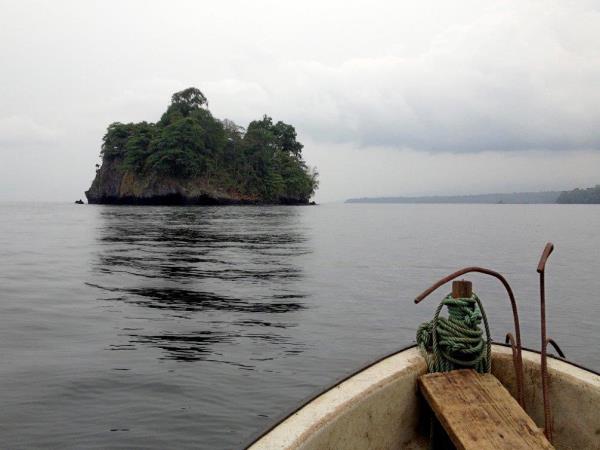
Equatorial Guinea small group holiday
The highlights of one of Africa’s least known countries
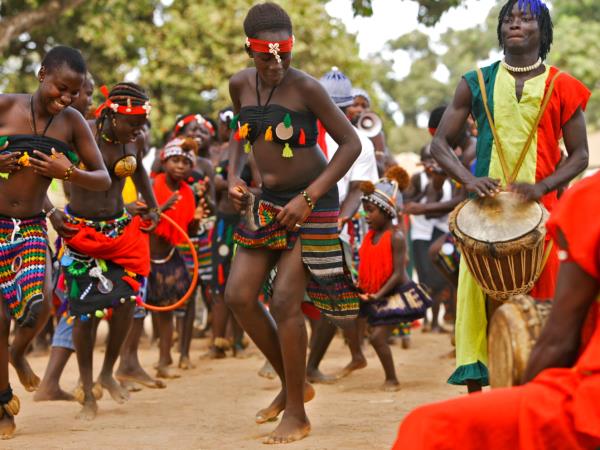
West Africa Explorer, Guinea-Bissau & Senegal
Historic towns, vibrant tribal culture & the Bijagos Islands
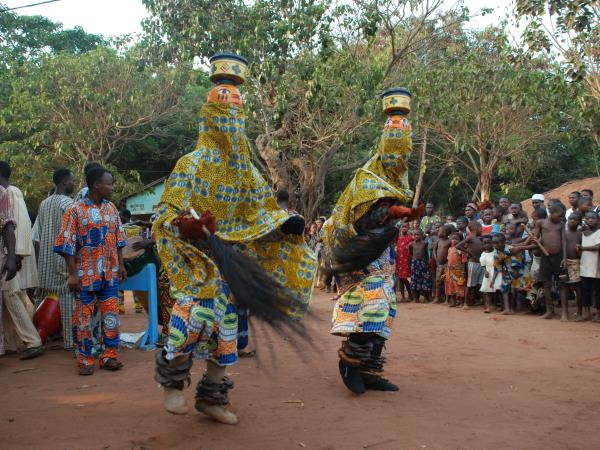
Ghana, Togo and Benin holiday, gold and magic
Traditional villages and voodoo in Ghana, Togo and Benin
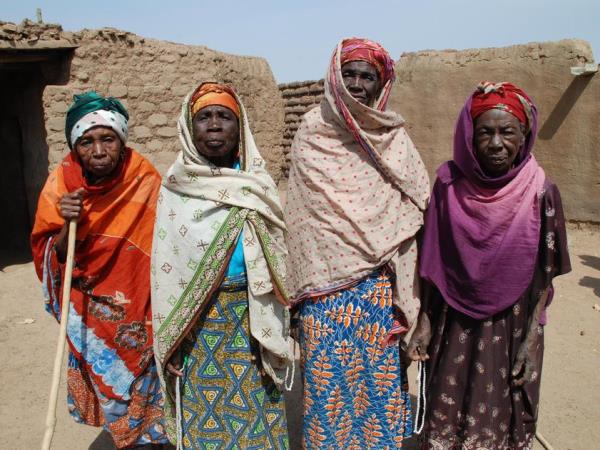
Cultural holiday in Ghana, Togo and Benin
Join an amazing group trip through Ghana, Togo and Benin.
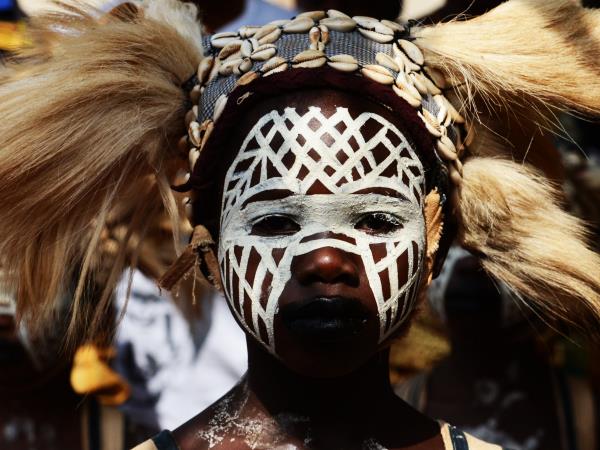
West Africa tour, Bissau to Cotonou
Voodoo heartlands, traditional storytellers and lush islands
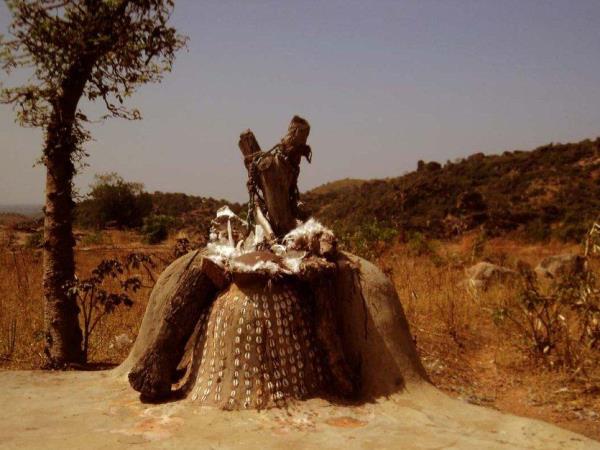
Ghana, Togo and Benin cultural holiday
Explore the unique African culture in three countries

See all our West Africa HolidaysGive us a call


West Africa map & highlights
Most of our West African holidays take advantage of these tightly clustered borders to visit more than one country on a 10-day or two-week trip. One classic combination is Ghana, Togo and Benin � for voodoo culture, slave forts and gorgeous coast, as well as the opportunity to discover both Anglo- and Francophone Africa. The other combo is Senegal and Guinea-Bissau, with brief excursions across the river into Mauritania.
If you�d rather stay in one place, Ghana and Senegal both offer ample attractions for a fortnight�s break. Alternatively, lengthier overland tours cross the Sahara, before reaching the lusher southern regions and finally the Atlantic. Organised tours � whether small group or tailor made � give access to these little visited corners of the world, with expert guides, local insight � and opportunities to encounter many local people along the way.

Give us a call to help with your itinerary
Source https://www.internetgeography.net/topics/what-is-nigerias-location-and-importance/
Source https://www.cia.gov/the-world-factbook/countries/nigeria/
Source https://www.responsibletravel.com/holidays/west-africa/travel-guide